IPowerful Cyclone Biparjoy will hit shores on Thursday in India and Pakistan, where more than 100,000 people have been evacuated as a precaution against the risk of flooding and the “total destruction” of certain buildings.
Biparjoy, which means “disaster” in Bengali, is currently sailing in the Arabian Sea and is expected for Thursday evening. The meteorological agencies of India and Pakistan are predicting a “very violent cyclone”.
Strong winds, storm surge (rising sea level) and torrential rains threatened some 325 kilometers of coastline between Mandvi, in the Indian state of Gujarat, and the Karachi region, Pakistan’s main city.
“More than 47,000 people have been evacuated from beaches and low-lying residential areas to shelters,” said CC Patel, manager of relief operations in Gujarat.
India’s weather agency predicts that Biparjoy will land in Jakhau port and warns of various types of damage: damage to crops, power and telecommunications networks, disruption of rail and road traffic or “total destruction” of traditional dwellings, which are made of dry earth. sludge and sheet metal.
At the water’s edge, gusts were blowing up to 180 km/h on Wednesday, according to meteorologists. Elsewhere in India, winds can reach 150 km/h.
In Pakistan, 62,000 people from the southeast coast have been admitted to 75 reception centres, mostly schools, said Climate Change Minister Sherry Rehman.
Pakistan meteorologists forecast wind gusts of up to 140 km/h over Sindh province (southeast).
Flooding is possible in Karachi, the regional capital and Pakistan’s largest city with 20 million people, Rehman said, adding that small planes had been told not to take off, and fishermen told to stay on the wharves.
“We are adopting the precautionary principle rather than a wait and see policy,” he told reporters in Islamabad. “Our priority is saving lives.”
“We will wither”
A refugee inside a school in Badin district, in Sindh, Wilayat Bibi fears for the future of his family, who live by the sea.
“How will we feed our children (after the cyclone)?”, the 80-year-old woman worries. “If our boat is destroyed, our hut is also destroyed, without anything we will be destroyed.”
Fishing has been suspended in the Indian state of Gujarat due to the extreme conditions.
Not far from Jakhau port, some 200 Kutch tribesmen from the nearby village of Ashiravandh sit on the ground at a local health centre, converted into a cyclone shelter. In the pouring rain as night falls, men brew tea in corners while women rock their babies to sleep.
Many are worried about cattle. Dhal Jetheeben Ladhaji, a pharmacist, said around 10 people had stayed behind to care for hundreds of animals essential to people’s livelihoods.
“We are terrified, we don’t know what will happen next,” Ladhaji, 40, told AFP.
Cyclones are common in this Indian Ocean region, home to tens of millions of people. But scientists explain that this phenomenon is gaining strength due to global warming.
One of them, a climatologist at the Indian Tropical Meteorological Institute, Roxy Mathew Koll, told AFP that the cyclone draws its energy from warm water and surface temperatures in the Omani sea are 1.2 to 1.4 degrees Celsius higher than four decades ago.
“The rapid warming of the Arabian Sea, coupled with global warming, is likely to increase the flux of heat from the ocean to the atmosphere and drive more intense cyclones,” he concluded.
06/15/2023 02:06:05 – Jakhau (India) (AFP) – © 2023 AFP
Get all the news straight to your inbox!
From Monday to Friday, receive every morning
headlines:
political, economic, social, sports…
dmp

“Twitter junkie. Hipster-friendly bacon expert. Beer ninja. Reader. Communicator. Explorer. Passionate alcohol geek.”







